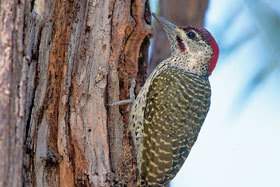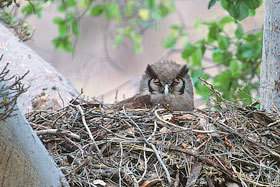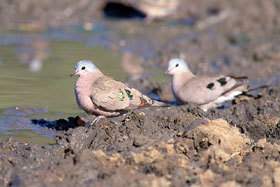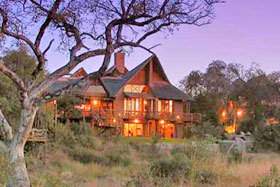
Birding Map of Kruger Park South-East Region
- Crocodile Bridge Area
- Crocodile Bridge to Sabie
- Lower Sabie to Skukuza
- Lower Sabie to Satara
- Crocodile Bridge to Malelane
- Crocodile Bridge to Skukuza
- Biyamiti Region
Biyamiti - The Heart of the Central Southern Kruger
The River supports beautiful tracts of riverine woodland which can best be experienced at Jock's Safari Lodge or Biyamiti Camp, both of which overlook the river. The vegetation of the central south is mixed bushwillow and acacia woodland with lots of Magic Guarris, Marulas and Leadwoods with Ebony Jackal-berries along the watercourses.
 Biyamiti Camp
Biyamiti Camp
Biyamati Rest Camp is an intimate, no-frills bush camp in the mixed woodlands on the Biyamiti River four kilometres upstream from its confluence with the Crocodile River. Unlike many other camps, the chalets are not set in a laager-like ring but in a loose line overlooking the river and the surrounding bush. There are 15 self-catering cottages, equipped with electricity, stoves, fridges and freezers. There is no shop or petrol station. Firewood is on sale at reception.
The Biyamiti is a seasonal river and is therefore usually dry, but that does not diminish the prolific birdlife. The Camp is a good, year-round birding spot, but it really comes alive in summer. There is a morning symphony of birdsong, punctuated by the rolling, rattling screech of the Woodland Kingfisher, the fluty dee-dee-deederik cry of Diderick Cuckoo and the raucuous chatter of Green Wood-Hoopoes and Arrow-marked Babblers which move through the camp in small parties.
The melody is picked up by the warbling duets of Black-crowned Tchagras, the rapid, varied whistling of the White-browed Scrub-Robins, the loud, ringing calls of the Yellow-throated Longclaws, and the complex, piping trills of the Red-faced Cisticolas which sing boldly from the long grass around the chalets.
Summer sightings in the woodland at Biyamiti Camp include Golden-tailed and Bennett's Woodpeckers, African Paradise-Flycatchers, Southern Black Tit, Violet-backed Starlings*, the Grey-headed and Orange-breasted Bush-Shrikes and Retz's Helmet-Shrike*.
The cuckoos are very active in early summer. At least four cuckoos are usually seen at the camp - Jacobin, Klaas's, Levaillant's* and Diderick Cuckoos. A tougher test is to find the Sombre Greenbul*, which calls from a well-hidden perch in the thicker bush on the edge of the camp.
Although Biyamiti is renowned for its woodland birds, there are good waterbird and wader sightings because the camp sits on the edge of the river. The Water Thick-knee* is a resident and is usually seen on the sandbanks of the riverbed.
Biyamiti Road (S139)
 One of Biyamiti's main drawcards is the road leading to the camp - the S139 - which follows the river through the mixed woodland. Only residents are allowed on this drive that dips over a number of watercourses that run into the Biyamiti. There are wonderful trees along the route - Leadwoods, Marulas and Weeping Boerbeans (which often grow on top of termite mounds). AT one get-out point there is a remarkable sight of a giant old fig and a Sausage-tree which have grown old together entangled splendour.
One of Biyamiti's main drawcards is the road leading to the camp - the S139 - which follows the river through the mixed woodland. Only residents are allowed on this drive that dips over a number of watercourses that run into the Biyamiti. There are wonderful trees along the route - Leadwoods, Marulas and Weeping Boerbeans (which often grow on top of termite mounds). AT one get-out point there is a remarkable sight of a giant old fig and a Sausage-tree which have grown old together entangled splendour.
In summer, the Woodland Kingfisher is visually and vocally conspicuous with its harsh, chattering call. The Red-backed Shrikes hawk from the roadside trees. Grey and Southern Yellow-Billed Hornbills hunt for insects along the road. More unusual birds along this drive are the Yellow-throated Longclaw and African Paradise-Flycatcher. Look for the White-crowned Bush-Shrikes along the S139.
The African-Hawk-Eagle and African Fish-Eagle are common raptors along this road, while the Shikra* is sometimes seen flying between copses of trees in the mixed woodland. It usually settles on a branch under the tree canopy to scan the surroundings for lizards, rodents and small birds. It then swoops on its prey, either seizing it from the ground or in flight. The Shikra is a very accurate striker, capable of taking a lizard off a flat, vertical surface without missing a wing beat.
There is a White-headed Vulture nest near Blinkwater Lookout Point, which offers a good view of Biyamiti, a few kilometers upstream of the Camp.
The area around the Biyamiti Water Hole windmill is usually the center of a lot of birding and animal activity. Game birds are also plentiful along this road - the Natal Spurfowl*, Helmeted Guineafowl, Swainson's Spurfowl*, Shelley's and Coqui Francolin, particularly during their summer breeding season. Some have suicidal tendencies so it's best to drive very slowly.
Chattering Wood-Hoopoes
Several African names for the noisy Green Wood-Hoopoe can be translated as the "hysterical laughter of woman". Singing the bushveld blues
Singing the bushveld blues
The mournful and melodious call of the Emerald-spotted Wood-Dove (Xivhambalana in Shangaan) is one of the classic sounds of the bushveld. The descending du du du du du is interpreted in Shangaan as 'My mother is dead, my father is dead, and my heart goes oh oh oh oh oh oh'.
The colourful dove, identified by its iridescent green wingspots, is also the source of the Shangaan-speaking cautionary to travelers, 'The Emerald Wood-Dove flies to the Xepa tree' means it's getting late, it is time to seek food and shelter for the night.
Where to stay Around Punda Maria


